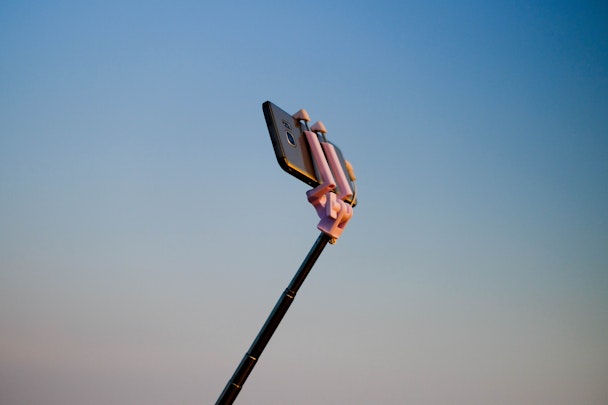‘Creators pay our bills’: how influencer marketers are evolving with creators
Nothing stays constant on social media. Trends explode then fizzle; stars rise and fall; today’s cool is tomorrow’s cringe. But our panel of leading influencer marketers from The Drum Network says lasting change is here.

How is the influencer marketing industry maturing? / Steve Gale via Unsplash
You don’t have to look hard to find eye-watering estimates of the size of the creator economy. Back in April, for example, Goldman Sachs predicted a total 2023 influencer marketing ad spend of over $6bn. That’s just a fraction of the investment bank’s more headline-grabbing prediction: of a ‘total addressable market’ (a rough calculation based on average earnings multiplied by an estimated 50 million global creators) rising from $250bn this year to $480bn by 2027.
The latter figures should be taken with a pinch of salt, but the story they tell is one that few industry figures would dispute: the market is huge – and growing. The lion’s share of that giant pot of money comes from brand deals – about 70% of total revenues, according to Goldman. So if predictions like these are even slightly right, brands will be sending a lot of money in creators’ directions in the coming years.
As this growth continues, the creator economy has been cleaning its act up. Not all that long ago, the darker corners of influencerdom were a wild west of vanity metrics, empty promises, different practices and not-always-clear standards. The last couple of years, though, have brought tightened regulation, the formation of trade bodies and specialist agencies selling to major players for impressive sums.
Advertisement
All hail the creator
One way of reading this raft of changes is as a shift in power toward creators, who know their worth, know the market and know what they do (and don’t) need from collaborators. “There’s an overall shift in the perception of influencers and in the maturity of the market,” says Hannah Anderson, managing director of Kyma Media.
“You go back eight or nine years and the influencer industry was trying to pull the wool over audiences’ eyes. That’s where any negative view of influencing came from: people shilling product without saying they were being paid to do so and being called sellouts. That’s massively matured now... the best creators really give a crap about their audience and they wouldn’t partner with someone with a bad product.”
‘Authenticity’ is the watchword here. Creators and brands alike know that the last generation of brand relationships is dead or dying and that smart activations can lean less on direct promotion and more on, well, influence. As Imogen Coles, UK influence lead at Ogilvy, puts it: “We’re seeing a reduction in the amount of revenue being driven by influencers-as-promoters. Rather than using influencers in the traditional way of holding up a product – which, can we please stop doing? – we’re looking at influencers as the entrepreneurs they are and as brands themselves.”
With a focus on community and connection, Coles suggests the industry has shifted away from the crude numbers game of promotion from the most-followed accounts and toward a rich tapestry of smaller and specialist creators, primed for connecting with fans in particular niches. “It’s only around 20% of the creator economy that the majority of brands are using. It’s the other 80% that we’re really seeing the growth in.”
Quite simply, says Social Chain’s chief exec Pete Metcalfe, “people who are engaging with influencers aren’t doing so to be advertised to” and, as the whole ecosystem reorients around that one fact, “the way that brands show up in that space will be the real evolution”.
Metcalfe goes on: “The elephant in the room is that different agencies have taken influencer marketing into different realms – one is very much upper-funnel, brand collaboration, which can live beyond social. At the other end, you’ve got purveyors of purely transactional, performance-based influence. For me, we talk about moving from transactional to meaningful interactions. That seems to be resonating more with clients.”
This might just amount to a wholesale re-imagining of influence. For Coles, influencers are not necessarily people with lots of followers online; they’re people with influence. “When my mother-in-law goes to bridge club with seven other women and she’s wearing a nail varnish they all love, she’d be the perfect influencer to those women.”
All of this puts creators, big and small, in a new position. In the early days of the influencer game, brands arguably treated them like traditional channels: broadcast routes for promotional messages. Now, marketers understand that what they’re paying for is something more personal to the creator – something about who they are and how they connect with those who follow them.
Here’s Anderson again: “We need to put the creators first. Creators pay our bills and they don’t have to do brand deals any more. Creators can make six or seven figures a month on Facebook, Snapchat or YouTube and then they can go and sell their own stuff. Tomorrow, all creators could decide they don’t want to do brand deals any more and we’re all out of a job. We have to show that the creator is involved in everything that we’re doing. That’s the only way that our industry is going to survive.”
Advertisement
Intention, purpose and transparency
Meanwhile, in policy and regulation, influencer marketers are asserting their own power. As Jordan Carroll, global innovation director at NewsUK influencer shop The Fifth, puts it: “I don't think people from the influencer world had a seat at the table when policy was designed in the past. Things would land on our table where it felt like influence was treated almost inequitably, compared with how TV advertising is policed, for instance. That has changed recently. We’ve seen trade bodies pop up, agencies have banded together and we do get consulted now on, say, ASA guidelines and CAP codes.”
Our panel is unanimous in its praise for this professionalization and what it signals about where the industry is headed. As Paula Albuquerque, head of MG Influencer at MG Empower, says: “All of this – the stricter regulations, the greater scrutiny of malpractice – sets the tone for the change we’re gearing toward, which is being more intentional, purposeful and transparent with content.”
Suggested newsletters for you
Paying attention
Perhaps the biggest battle that influencer marketers have been fighting in recent years has been around finding ironclad measurement and attribution to show the channel’s reach and efficiency.
“In influence, we earn attention,” says Metcalfe. “The difficult thing is in that disconnect – articulating measurement. The future is in standardizing, simplifying and cutting through what is attention. We work with measurement frameworks that we’ve massively refined, but we’re still dealing with a shit-ton of KPIs to measure attention… Rather than having a standardized measurement framework similar to what Barb is for TV, influencer still feels hard to do.“
Anderson says: “It’s impossible to measure human emotion or perception en-masse. Therefore, until we can tap into people’s brains, we can never truly understand the impact that an influencer has. Really, it has been the same since I’ve been in this world… people know what works, but it’s very difficult to measure and attribute an uplift in spend or whatever.”
Solving that conundrum remains influencer marketing’s million- (or billion-) dollar question. Here’s one route our panel recommends: focusing on retention alongside attention. As Albuquerque says: “Retention translates what influence is about as a channel. You can get other mediums to drive eyeballs, but the creator economy is about being able to drive engagement and long-lasting value to consumers and having influencers as a proxy for that.”
Another way out of that bind is to turn, once again, to the creators themselves says Shivani Choda, head of digital at PR agency The Romans: “We want to see that insight about objectives and results coming from the creator. You can get that insight from them. What would they do if they were in your audience’s shoes? What would resonate with them? That can give a super clear picture of what success truly looks like.”
A final (part) solution relates back to the idea of the influencer realm outgrowing its traditional parameters. As Ogilvy’s Coles puts it: “Influencer is almost always better when it’s integrated. So measurement now is not about looking at how it was done in traditional media, but integrating it all together. Most of our influencer work now will integrate into the paid – it’s all about using those mediums together to create far more efficient, far more impactful work.”
Content created with:

Kairos Group
Led by experts with more than 100+ years of gaming and media industry knowledge, Kairos Group comprises multiple entities including Kairos Media, Kyma Media and...
Find out more
Ogilvy UK
Ogilvy is all about depth and breadth - we have London's broadest and deepest skillset in communications our award-winning teams work fluidly across our core capabilities...
Find out more
SocialChain
We strengthen your SocialChain by building stronger connections between people and brands.
With hubs in Manchester, London and New York, we are a creator...

THE FIFTH
We built the agency with one clear mission: to do things differently.
The agency was founded on a mutual understanding of what it means to have real influence...

MG Empower
We are a fully integrated marketing powerhouse offering a range of best-in-class marketing services, from community-building and brand co-creation to amplification...
Find out more
The Romans
We’re bored of boring PR. Founded in 2015 and backed by advertising agency Mother, our team has worked with some of the world’s most exciting brands and created...
Find out more
